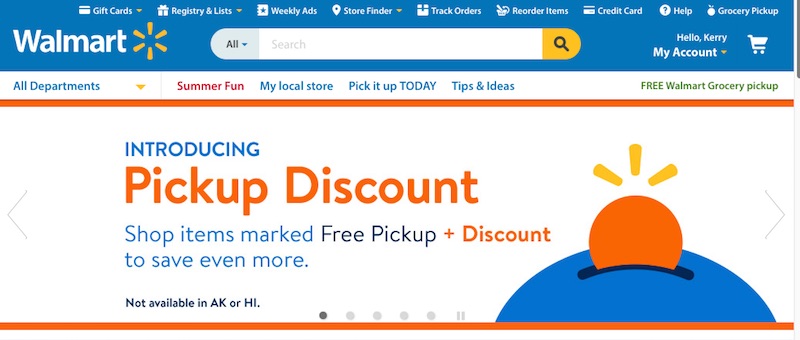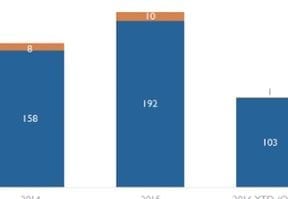
Walmart is spending heavily to enhance its ecommerce capabilities. This includes acquiring innovative ecommerce retailers and investing in technology infrastructure. Walmart’s “Pickup Discount,” shown above, rewards customers who buy online and pick up at a local Walmart store.
After an ecommerce power-up that included acquiring a string of online retailers, including Jet.com, Walmart took a major swing at Amazon by offering free 2-day shipping for qualified orders of $35 or more, no special membership required. Amazon was quick to respond by lowering its free 2-day shipping threshold to $25 for non-Prime members and offering 45 percent off Prime membership for low-income shoppers.
The competition is heating up, but which company will win?
Let’s look at the numbers.
Amazon has a current market cap of $477 billion and $21.5 billion of cash on hand. Its 2016 revenue was $136 billion. Through innovation, smart business tactics, and sheer brute force it has been able to grow year after year and dominate American ecommerce. Investors and analysts seem to be betting on Amazon, pushing its share price past $1,000 for the first time in May.
Walmart, however, cannot be easily dismissed. Despite the financial and tech sector hype surrounding Amazon, Walmart is a juggernaut with a market cap of $236 billion and a physical store presence within 10 miles of 90 percent of all Americans. Its total revenue for 2016 was $482 billion, and with Jet.com founder Marc Lore at the helm, Walmart’s ecommerce sales for the quarter ended April 30, 2017 grew by an an impressive 63 percent.
Walmart is therefore in a unique position to make large moves against Amazon. It has both the deep pockets and widespread profitable physical store presence to do so.
But my bet is that neither company will achieve true dominance. Instead, their clash will be long and brutal, causing huge disruption in retail.
Actions from Walmart
Let’s consider some of the actions Walmart might take against Amazon.
1. Attack free shipping. Walmart is offering discounts to customers who are willing to pick up their orders at Walmart locations. Additionally, it is taking the unprecedented step of enlisting its own store employees to drop packages off on their way home from work. These moves help mitigate the high costs of last mile delivery for Walmart and could allow it to again drop its free 2-day delivery threshold below Amazon’s current $25.
These steps hit at Amazon’s greatest weakness as an online retailer: its lack of a widespread physical presence. In addition to reducing prices and lowering 2-day shipping thresholds, Amazon will likely have to continue expanding the number of its distribution centers, pickup locations, and physical stores — this could be the logic behind its recent $13.7 billion acquisition of Whole Foods Market.
2. Challenge other Prime benefits. With 49 million members spending twice as much as non-members, Prime is a major cash cow for Amazon. Prime isn’t just about retail however. The program offers a slew of other perks, including free movies, television shows, books, magazines, and music streaming. Walmart may have to offer its own version of Prime to draw these members away from Amazon.
Walmart would therefore be smart to partner with Netflix, Hulu, or HBO to offer similar entertainment perks through a revamped membership program. It could develop a cheaper program with enough additional features to entice members away from Prime.
3. Deflect Amazon’s moves into pharmaceuticals. Industry observers have been predicting Amazon moves into pharmaceuticals for a while. The healthcare industry accounts for nearly 18 percent of U.S. gross domestic product. Pharmaceuticals would be a logical next step for the ecommerce giant.
To deflect this, Walmart could aggressively push its pharmaceutical weight around. It’s the fourth largest U.S. pharmacy by total revenue, with thousands of pharmacies across the U.S. Should it begin offering deeper discounts on generic drugs and ramping up its online prescription services to include same day delivery, Walmart could make it difficult for Amazon to get traction in this industry.
4. Move into tech. In the last year, Walmart has acquired Jet.com, Hayneedle.com (home decor), Shoes.com, Moosejaw (brick-and-click retailer of outdoor recreation gear), and Modcloth.com (women’s apparel).
As Walmart’s ecommerce portfolio expands, it will need computing infrastructure similar to Amazon’s that is automated and standardized among all of its retail businesses — essentially turning Walmart into a giant tech company. Walmart C.E.O. Doug McMillon acknowledged this reality when he recently stated, “Rapid advances in technology mean we need to become more of a digital enterprise, and that’s what we’re doing.”
Building such infrastructure would also provide Walmart with another angle to attack Amazon. Like Amazon Web Services, Walmart could lease out its cloud computing assets, using the profits to pay for the investment and, also, subsidize its retail business.
Other Retailers and Brands
The good news for the rest of the industry is that Walmart and Amazon’s battle for market share will create opportunities for other retailers and brands.
Investments made by these industry titans will likely lead to updated technology, the development of highly efficient supply chains, and a pool of expert talent familiar with it all. Smaller companies will reap the fruits of such innovations.
Additionally, lower prices and shipping thresholds will spur the growth of ecommerce as more consumers take advantage of these savings. For example, Amazon’s recent grab for Walmart’s low-income customers could introduce a new demographic to online shopping. This is good for other ecommerce companies.
In short, the two groups of winners in this clash of titans will be those brands and retailers that take advantage of the opportunities, and ecommerce consumers, who will reap the cost and timesaving benefits.



